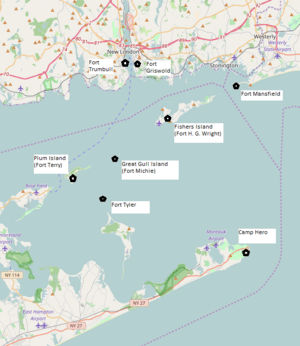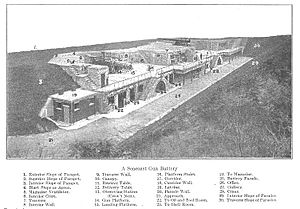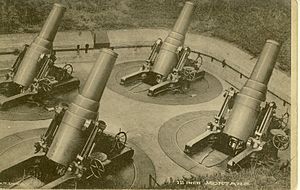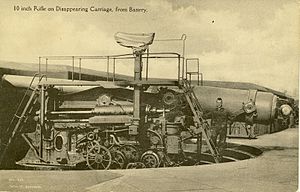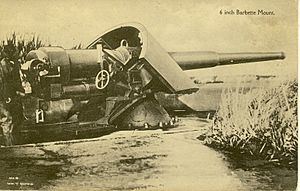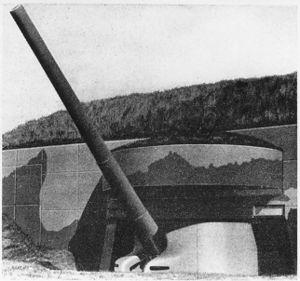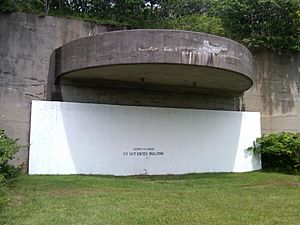Harbor Defenses of Long Island Sound facts for kids
Quick facts for kids Harbor Defenses of Long Island Sound |
|
|---|---|
| Active | 1900-1950 |
| Country | |
| Branch | United States Army Coast Artillery Corps |
| Type | Coast artillery |
| Role | Harbor Defense Command |
| Part of |
|
| Garrison/HQ | Fort H. G. Wright, Fishers Island, New York |
| Motto(s) | Stop |
| Mascot(s) | Oozlefinch |
The Harbor Defenses of Long Island Sound was a special part of the United States Army Coast Artillery Corps. Its job was to protect the coastlines of Long Island Sound and Connecticut. This defense system was active from 1895 to 1950. It included forts with big guns and hidden underwater minefields.
The main goal was to protect the water route to New York City. It also guarded important port cities like New London, New Haven, and Bridgeport. Later, it protected the submarine base and shipyard in Groton. This defense group started around 1900. It was first called an Artillery District, then "Coast Defenses of Long Island Sound" in 1913. Finally, it became "Harbor Defenses of Long Island Sound" in 1925.
History of Coastal Protection
Early Forts in Connecticut
Colonial Defenses
Connecticut didn't have many coastal forts in the early days. Some forts were mentioned in New Haven and New London. For example, a fort was built in New Haven in 1657. In Old Saybrook, British Fort Saybrook was built in 1635. It was rebuilt in 1648 and successfully stopped a Dutch attack in 1675.
Revolutionary War Forts
During the American Revolutionary War, Connecticut built several forts. The two biggest were Fort Trumbull in New London and Fort Griswold in Groton. Smaller forts were also built in New Haven and Bridgeport. These were mostly built between 1775 and 1778. After a British attack in 1781, Fort Stamford was quickly built.
British forces attacked Connecticut several times. In July 1779, they raided New Haven, Fairfield, and Norwalk. They burned Fairfield and Norwalk. The most famous attack was by Benedict Arnold in September 1781. His forces easily took Fort Trumbull. They faced strong resistance at Fort Griswold in the Battle of Groton Heights. Sadly, many defenders of Fort Griswold were killed after they surrendered. The British then burned New London.
Forts from 1783 to 1812
Fort Trumbull was repaired in 1795 and 1799. It was rebuilt in 1813 with 18 guns during the War of 1812. Fort Griswold also got some repairs. The British were able to blockade New London during the war. This trapped three warships in the Thames River. A new fort, Fort Hale, was built in New Haven in 1809-1812.
The most famous event in Connecticut during the War of 1812 was the attack on Stonington Borough. British warships demanded the town surrender. The town refused, even though it only had two cannons. After three days of bombing, the town held strong. Stonington's two original cannons are still there today.
Fort Upgrades (1816-1890)
After the War of 1812, the US Congress decided to build stronger forts. These new forts were made of masonry (stone and brick). Fort Trumbull was completely rebuilt from 1839 to 1850. It was designed by Joseph Totten, a top fort designer. The new Fort Trumbull had five sides and could hold up to 42 guns. It also had defenses for close-up attacks.
The Groton Monument was built near Fort Griswold in 1825-1830. Fort Griswold's water battery was rebuilt in the 1840s. During the American Civil War, forts in Connecticut were used as training centers. Fort Trumbull became a headquarters. Fort Nathan Hale in New Haven was built in 1863. It was an earthwork fort with 18 guns.
The Civil War showed that stone forts could be damaged by new, powerful cannons. So, new earth-protected batteries were built in the 1870s. However, Connecticut did not get these new forts at that time.
The Endicott Era of Fort Building
In 1885, a group called the Board of Fortifications suggested building completely new coast defenses. Construction began in 1897 to protect Long Island Sound. Three large forts and one small fort were built. The large forts were Fort H. G. Wright on Fishers Island, Fort Michie on Great Gull Island, and Fort Terry on Plum Island. These forts are all in New York state. They are located where Long Island Sound meets Block Island Sound. The small fort was Fort Mansfield in Westerly, Rhode Island.
Underwater minefields, controlled from Fort H. G. Wright and Fort Terry, also guarded the Sound. As cannons could shoot further, the new forts were built closer to the sea. Fort Trumbull was the first headquarters, but in 1910, this moved to Fort H. G. Wright.
These new forts had very powerful weapons. Fort H. G. Wright had a rare 15-inch dynamite gun. It also had eight 12-inch mortars and pairs of 12-inch and 10-inch "disappearing guns." These guns would pop up to fire and then hide to reload. Fort Michie had 12-inch and 10-inch guns. Fort Terry had 12-inch mortars and 10-inch disappearing guns. All these forts also had smaller 6-inch and 3-inch guns to protect the minefields. Fort Mansfield had 8-inch and 5-inch disappearing guns. Most of these forts were finished by 1906.
The Spanish–American War started in 1898. Many of the new forts were not yet finished. So, some older cannons were quickly set up. Fort Terry received a 4.72-inch gun from the United Kingdom. A new fort, Fort Tyler, was built south of Plum Island. It was planned to have 8-inch and 5-inch guns, but it seems it was never fully armed. The older cannons were removed after the war.
Fort Mansfield was meant to guard the narrow passage between Rhode Island and Fishers Island. But in 1907, a test showed that enemies could land on a nearby beach that the guns couldn't reach. So, the fort was closed in 1909. Its guns were removed for World War I, and the fort was sold in 1928.
Naval bases and shipyards became very important in the Long Island Sound area. The New London Navy Yard, now the Naval Submarine Base New London, was set up in 1872. Submarines returned to the Groton base in 1915. Companies like Electric Boat also built submarines in Groton and Bridgeport.
World War I Changes
When America entered World War I, many changes happened. Temporary buildings were put up at the forts for new soldiers. The Coast Artillery, which had experience with big guns, was chosen to operate heavy artillery in the war. Many guns were removed from forts to be sent to Europe. Some were put on railway cars to move them around. Others became field guns on wheels.
Because of these changes, the mortar batteries at Fort H. G. Wright and Fort Terry were cut in half. Many 6-inch guns were also removed. However, the 10-inch and 12-inch guns at Long Island Sound forts stayed. This was probably because they were used for training.
Between the World Wars
After World War I, anti-aircraft (AA) batteries were built at some forts. These had 3-inch guns to shoot down enemy planes. These AA guns were placed at all three major Long Island Sound forts.
In the 1920s, the Coast Artillery developed a new, very powerful weapon: the 16-inch gun M1919. The first of these was placed at Fort Michie. This gun could shoot much further than older ones. All later 16-inch guns were designed to shoot at a high angle. This allowed them to hit the weaker top armor of enemy ships.
In 1925, the defense commands were renamed "Harbor Defenses." The 11th Coast Artillery was the main Army unit for HD Long Island Sound. The 242nd Coast Artillery was the National Guard unit.
In 1930, a defense exercise included planes and submarines. The planes were based in Groton, and the submarines came from the nearby base. This helped the military learn how to use different forces together.
Fort Trumbull became the home of the Revenue Cutter Academy in 1910. This later became the United States Coast Guard Academy. The Academy moved to its current location in New London in 1932.
In 1938, a big hurricane badly damaged most of Fort Michie's buildings.
World War II Defenses
At the start of World War II, many temporary buildings were again built for soldiers. The Army decided to replace most older heavy guns with 16-inch guns. HD Long Island Sound's main defense became Camp Hero in Montauk, at the eastern tip of Long Island. This new fort was built even further out to sea.
Camp Hero had two hidden batteries, each with two 16-inch guns. These batteries were built in secret, and the camp buildings were spread out to look like a normal town. Another 16-inch battery was planned for Fort H. G. Wright, but the guns were never mounted.
New 6-inch gun batteries were also built. These had strong concrete bunkers for ammunition. The guns were protected by open shields. Many of these 6-inch guns were ones that had been removed in World War I and stored. Four of these batteries were built in HD Long Island Sound.
Two batteries of 155 mm guns were also set up in 1942. These guns were on "Panama mounts," which are circular concrete platforms. One was in Rhode Island, and the other at Fort Terry. Most of these were removed by 1944.
As the new defenses were built, most older guns were removed and scrapped. However, some 6-inch and 3-inch guns stayed in use.
At least five 90 mm gun batteries were built in the Long Island Sound area. These guns could shoot at both ships and planes. They were placed at Fort Terry, Fort Michie, Fort H. G. Wright, and near the Thames River.
The US Navy also helped defend the area. They used nets and special sensors to detect submarines. Fort Trumbull became a training school for Merchant Marine officers. It also hosted a sonar laboratory during the war.
After 1941, HD Long Island Sound was part of the Eastern Defense Command. This command was in charge of all east coast defenses. In 1944, HD Long Island Sound was officially disbanded. Its soldiers and equipment were moved to the Harbor Defenses of New York.
After World War II
After the war, it became clear that big gun defenses were no longer needed. They were scrapped by 1948. In 1950, the Coast Artillery Corps was dissolved. Today, the Air Defense Artillery carries on some of its history.
In the 1950s, Nike missile sites were built around some cities, but not at the old Long Island Sound forts. These missile sites were closed around 1972.
Current Status of Forts
Today, Fort Trumbull in New London and Fort Griswold in Groton are well-preserved state parks. Visitors can explore them and see some historic cannons. The two 18-pounder cannons that defended Stonington Borough in the War of 1812 are still on display there.
In New Haven, Fort Nathan Hale and Black Rock Fort are also open to the public. Some parts of Fort Stamford in Stamford still remain. A park is at the site of Fort Saybrook, but little of the original fort is left.
Many buildings at Fort H. G. Wright on Fishers Island are now used for other purposes. Some gun batteries are open to the public. The 16-inch Battery 111 is owned by the Navy but can be seen from outside. The unique spot where the 15-inch dynamite gun was located is still there.
Fort Michie and its 16-inch gun spot are well-preserved. However, the island is owned by the American Museum of Natural History for bird studies. You need to arrange a visit beforehand. Much of Fort Terry was used by an Animal Disease Center, and its batteries are still there. Plum Island also requires prior arrangement to visit.
Fort Tyler was used as a bombing range in World War II. Its island has changed a lot, damaging the fort. Camp Hero is well-preserved. Its 16-inch gun batteries can be viewed from outside. Fort Mansfield is still at the end of Napatree Point, but parts of it have been lost to beach erosion.
What the Forts' Symbol Means
- Shield: The shield is gold with a blue diagonal stripe. On the stripe are three silver towers. This stripe with towers shows the three main forts (Wright, Michie, and Terry) that guarded the entrance to the Sound. The narrow black lines on each side of the stripe stand for the strong iron defenses.
- Crest: The crest is the head of a fish hawk, also known as an osprey. These birds are common in the area.
- Motto: The motto is a command to any enemy: Stop.
- History: This symbol was first approved in 1919 for the Coast Defenses of Long Island Sound. In 1924, the osprey head was adopted by the 11th Coast Artillery Regiment.


